One-Sided Continuity. Classification of Discontinuities
Similarly to the one-sided limits, we can define one-sided continuity.
Definition. Function $$${f{{\left({x}\right)}}}$$$ is continuous from the right at point $$${a}$$$ if $$$\lim_{{{x}\to{{a}}^{+}}}={f{{\left({a}\right)}}}$$$. Function $$${f{{\left({x}\right)}}}$$$ is continuous from the left at point $$${a}$$$ if $$$\lim_{{{x}\to{{a}}^{{-}}}}{f{{\left({x}\right)}}}={f{{\left({a}\right)}}}$$$.
Clearly, if function is continuous from the left and from the right at point $$${a}$$$, then it is continuous at point $$${a}$$$.
Definition. Function $$${f{}}$$$ is discontinuous at $$${a}$$$ if it is not continuous.
There are three kinds of discontinuity at $$${a}$$$:
- Removable Discontinuity: if $$$\lim_{{{x}\to{a}}}{f{{\left({x}\right)}}}$$$ exists and finite, but function is either undefined at point $$${a}$$$ or $$$\lim_{{{x}\to{a}}}{f{{\left({x}\right)}}}\ne{f{{\left({a}\right)}}}$$$. It is called removable because this discontinuity can be removed by redefining function as $$${g{{\left({x}\right)}}}={\left\{\begin{array}{c}{f{{\left({x}\right)}}}{\quad\text{if}\quad}{x}\ne{a}\\\lim_{{{x}\to{a}}}{f{{\left({x}\right)}}}{\quad\text{if}\quad}{x}={a}\\ \end{array}\right.}$$$
- Jump or Step Discontinuity: if one-sided limits exist and finite but not equal.
- Infinite or Essential Discontinuity: if one or both of the one-sided limits don't exist or are infinite.
Let's go through a couple of examples of these discontinuities.
Example 1. Find where function $$${f{{\left({x}\right)}}}=\frac{{{{x}}^{{2}}+{2}{x}-{3}}}{{{x}-{1}}}$$$ is discontinuous and classify this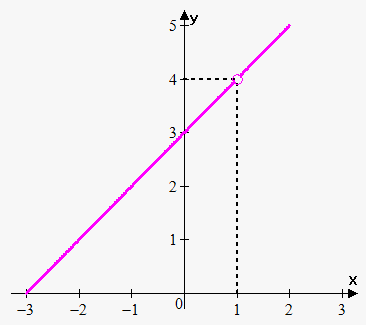 discontinuity.
discontinuity.
This function is rational, so it is continuous everywhere, except where denominator equals 0, i.e. where $$${x}-{1}={0}$$$. So, functions is not defined (and not continuous) when $$${x}={1}$$$.
Now, $$$\lim_{{{x}\to{1}}}\frac{{{{x}}^{{2}}+{2}{x}-{3}}}{{{x}-{1}}}=\lim_{{{x}\to{1}}}\frac{{{\left({x}+{3}\right)}{\left({x}-{1}\right)}}}{{{x}-{1}}}=$$$
$$$=\lim_{{{x}\to{1}}}{\left({x}+{3}\right)}={4}$$$.
Thus, limit exists and finite, but $$${f{{\left({1}\right)}}}$$$ is not defined, so $$${x}={1}$$$ is removable discontinuity.
Example 2. Find where function $$${f{{\left({x}\right)}}}={\left\{\begin{array}{c}\frac{{{{x}}^{{2}}+{2}{x}-{3}}}{{{x}-{1}}}{\quad\text{if}\quad}{x}\ne{1}\\{2}{\quad\text{if}\quad}{x}={1}\\ \end{array}\right.}$$$ is discontinuous and classify this discontinuity.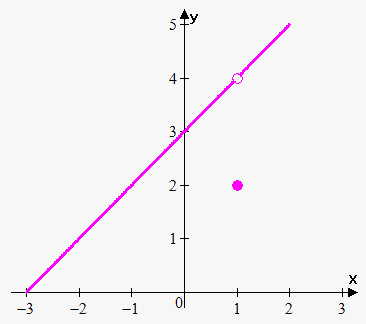
This is actually same example as example 1, except that function is defined at $$${x}={1}$$$.
Again $$$\lim_{{{x}\to{1}}}\frac{{{{x}}^{{2}}+{2}{x}-{3}}}{{{x}-{1}}}={4}$$$, but $$${f{{\left({1}\right)}}}={2}$$$, so $$$\lim_{{{x}\to{1}}}\frac{{{{x}}^{{2}}+{2}{x}-{3}}}{{{x}-{1}}}\ne{f{{\left({1}\right)}}}$$$.
Thus, $$${x}={1}$$$ is point of removable discontinuity.
As in example 1 we can make function continuous by redefining function as $$${f{{\left({x}\right)}}}={\left\{\begin{array}{c}\frac{{{{x}}^{{2}}+{2}{x}-{3}}}{{{x}-{1}}}{\quad\text{if}\quad}{x}\ne{1}\\{4}{\quad\text{if}\quad}{x}={1}\\ \end{array}\right.}$$$.
Example 3. Find where function $$${f{{\left({x}\right)}}}={\left\{\begin{array}{c}{x}+{1}{\quad\text{if}\quad}{x}\le{2}\\{4}-{x}{\quad\text{if}\quad}{x}>{2}\\ \end{array}\right.}$$$ is discontinuous and classify 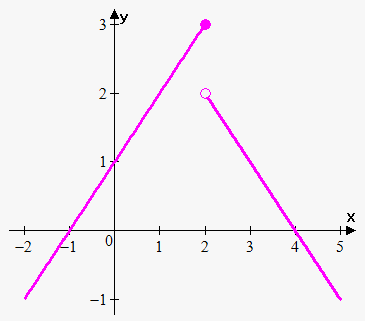 this discontinuity.
this discontinuity.
Clearly linear functions are continuous everywhere, but since $$$\lim_{{{x}\to{{2}}^{{-}}}}{f{{\left({x}\right)}}}=\lim_{{{x}\to{{2}}^{{-}}}}{\left({x}+{1}\right)}={3}$$$ and $$$\lim_{{{x}\to{{2}}^{+}}}{f{{\left({x}\right)}}}=\lim_{{{x}\to{{2}}^{+}}}{\left({4}-{x}\right)}={2}$$$ then $$$\lim_{{{x}\to{{2}}^{{-}}}}{f{{\left({x}\right)}}}\ne\lim_{{{x}\to{{2}}^{+}}}{f{{\left({x}\right)}}}$$$.
This means that at $$${x}={2}$$$ there is jump discontinuity.
Also note, that $$$\lim_{{{x}\to{{2}}^{{-}}}}{f{{\left({x}\right)}}}={3}={f{{\left({1}\right)}}}$$$, this means that function is continuous from the left at $$${x}={2}$$$.
Example 4. Find where function $$${f{{\left({x}\right)}}}=\frac{{1}}{{{x}-{1}}}$$$ is discontinuous and classify this discontinuity.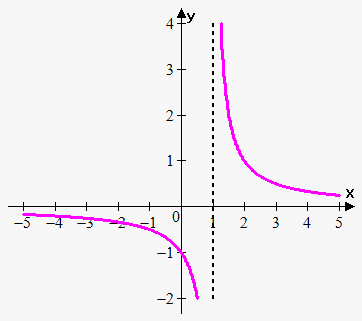
This function is rational, so it is continuous everywhere, except where denominator equals 0, i.e. where $$${x}-{1}={0}.$$$ So, functions is not continuous when $$${x}={1}$$$.
Now, $$$\lim_{{{x}\to{{1}}^{+}}}\frac{{1}}{{{x}-{1}}}=\infty$$$.
This means that at $$${x}={1}$$$ there is infinite discontinuity.
Actually infinite discontinuity occurs when we have vertical asymptote.
Example 5. Find points where function $$${f{}}$$$ is discontinuous and classify these points: 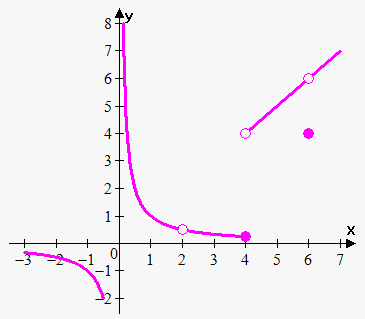 $$${f{{\left({x}\right)}}}={\left\{\begin{array}{c}\frac{{1}}{{x}}{\quad\text{if}\quad}{x}<{2}\\\frac{{1}}{{x}}{\quad\text{if}\quad}{2}<{x}\le{4}\\{x}{\quad\text{if}\quad}{4}<{x}<{6}\\{4}{\quad\text{if}\quad}{x}={6}\\{x}{\quad\text{if}\quad}{x}>{6}\\ \end{array}\right.}$$$
$$${f{{\left({x}\right)}}}={\left\{\begin{array}{c}\frac{{1}}{{x}}{\quad\text{if}\quad}{x}<{2}\\\frac{{1}}{{x}}{\quad\text{if}\quad}{2}<{x}\le{4}\\{x}{\quad\text{if}\quad}{4}<{x}<{6}\\{4}{\quad\text{if}\quad}{x}={6}\\{x}{\quad\text{if}\quad}{x}>{6}\\ \end{array}\right.}$$$
Function is discontinuous at 0 because $$$\lim_{{{x}\to{{0}}^{+}}}{f{{\left({x}\right)}}}=\lim_{{{x}\to{{0}}^{+}}}\frac{{1}}{{x}}=\infty$$$. So, at function $$${x}={0}$$$ we have infinite discontinuity.
Function is dicontinuous at 2 because $$${f{{\left({2}\right)}}}$$$ is simply not defined. Since $$$\lim_{{{x}\to{{2}}^{{-}}}}\frac{{1}}{{x}}=\lim_{{{x}\to{{2}}^{+}}}\frac{{1}}{{x}}=\frac{{1}}{{2}}$$$ then $$$\lim_{{{x}\to{2}}}\frac{{1}}{{x}}=\frac{{1}}{{2}}$$$ and so $$${x}={2}$$$ is removable discontinuity.
Since $$$\lim_{{{x}\to{{4}}^{{-}}}}{f{{\left({x}\right)}}}=\lim_{{{x}\to{{4}}^{{-}}}}\frac{{1}}{{x}}=\frac{{1}}{{4}}$$$ and $$$\lim_{{{x}\to{{4}}^{+}}}{f{{\left({x}\right)}}}=\lim_{{{x}\to{{4}}^{+}}}{x}={4}$$$ then $$$\lim_{{{x}\to{4}}}{f{{\left({x}\right)}}}$$$ doesn't exist because one-sided limits are not equal.
This means that $$${x}={4}$$$ is jump discontinuity.
Since $$$\lim_{{{x}\to{{6}}^{{-}}}}{f{{\left({x}\right)}}}=\lim_{{{x}\to{{6}}^{{-}}}}{x}={6}$$$ and $$$\lim_{{{x}\to{{6}}^{+}}}{f{{\left({x}\right)}}}=\lim_{{{x}\to{{6}}^{+}}}{x}={6}$$$ then $$$\lim_{{{x}\to{6}}}{f{{\left({x}\right)}}}={6}$$$ but $$${f{{\left({6}\right)}}}={4}\ne{6}$$$, so $$$\lim_{{{x}\to{6}}}{f{{\left({x}\right)}}}\ne{f{{\left({6}\right)}}}$$$.
This means that $$${x}={6}$$$ is removable discontinuity.
Example 6. Conside function $$${f{{\left({x}\right)}}}={\left[{x}\right]}$$$ where $$${\left[{x}\right]}$$$ is a floor function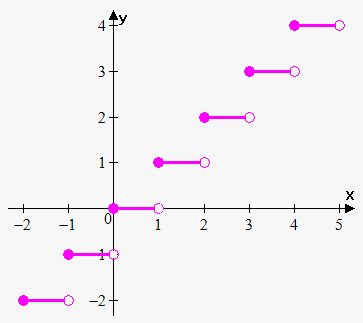 .
.
This function is discontinuous at every integer point $$${x}={n}$$$, because $$$\lim_{{{x}\to{{n}}^{{-}}}}{\left[{x}\right]}={n}-{1}$$$ and $$$\lim_{{{x}\to{{n}}^{+}}}{\left[{x}\right]}={n}$$$.
So one-sided limits are finite but not equal. This means that at every integer point $$${x}={n}$$$ there is jump discontinuity.
Also, note that $$${f{{\left({n}\right)}}}={n}=\lim_{{{x}\to{{n}}^{+}}}{f{{\left({x}\right)}}}$$$ that's why at every integer point $$${x}={n}$$$ function is continuous from the right.
